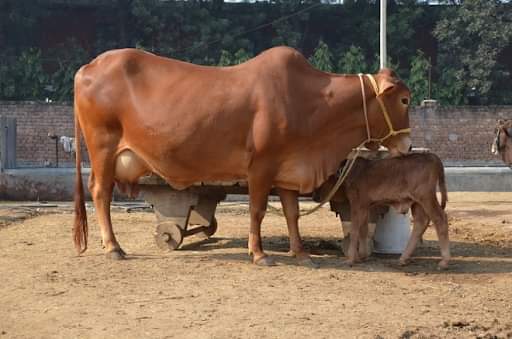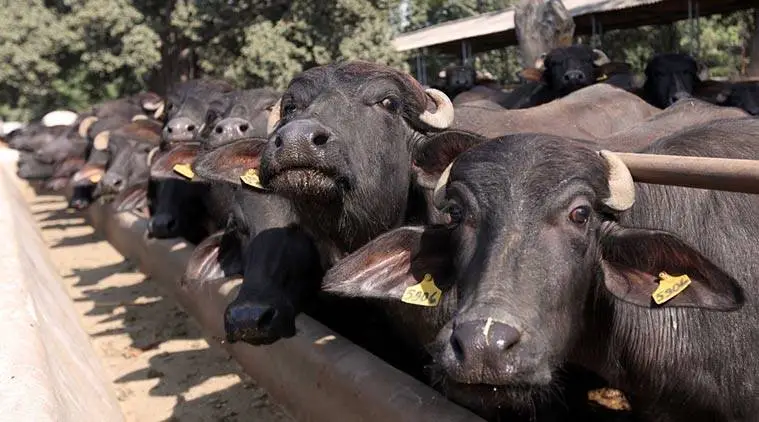Don’t allow it to be cowed down
Almost half of India’s milk, with higher solids, comes from buffaloes. Yet, this low-maintenance and efficient feed-converting animal finds little place in our dairy and livestock policy.
It is surprising to see the buffalo being accorded very little space in any serious public discourse on dairying within India. (File)Italy has just four lakh buffaloes, which it guards as a precious national resource. Mozzarella cheese, indispensable to pizza, owes its origins to milk from the Italian water buffalo. Buffalo mozzarella from Southern Italy’s Campania region enjoys both geographical indication/designation of origin and trademark protection as “Mozzarella Di Bufala Campania”.
India, by contrast, has 109.85 million buffaloes, as per the latest Livestock Census for 2019. Moreover, as the accompanying chart shows, the country’s buffalo population has been rising, even while cattle numbers have fallen during the last three decades. In 2018-19, buffaloes contributed to 91.82 million tonnes (mt) or 48.9% of our estimated total milk production of 187.75 mt — more than the 51.26 mt from crossbred/exotic cows and 38.57 mt from indigenous/nondescript cattle. India also houses over 56% of the world’s buffalo stock.
Yet, for some unexplained reasons, we have relegated the buffalo to the margins of livestock policy and governance. Till 1999, Codex Alimentarius — the international standards, guidelines and codes of practices relating to food safety and quality — mandated separate labeling for milk that was from a genus or species other than cow (Bos Taurus), thereby automatically excluding the buffalo (Bubalus bubalis). The stakes for India being very high, a definition proposed by us got adopted after much discussion under Codex Standard 206-1999. Milk now included “the normal mammary secretion of [all] milking animals” and these covered cows and buffaloes as well as goats and sheep. Interestingly, the US Department of Agriculture, even today, takes into account only “cow milk” in its world dairy markets and trade reports!
While ignorance in western nations, deliberate or otherwise, is understandable, it is surprising to see the buffalo being accorded very little space in any serious public discourse on dairying even within India. This is all the more striking when the bulk of pouched milk sold here is a mix of both cow and buffalo milk. Also, our own traditional standards for milk, including the procurement price paid to farmers, have been determined by the percentage of fat. Buffalo milk contains higher fat (6.5-7%) as well as solids-not-fat (9-9.7%) content than the corresponding 3-3.5% and 8.3-8.8% levels for cow milk.
One reason for the cow’s elevated status even in India may have to do with religious and cultural beliefs, although it holds no distinct advantage over the buffalo in pure dairy economics terms. If anything, the spiritual halo around the cow imposes restrictions on harnessing its full economic potential. While there are those who propagate the virtues of cow milk, scientific evidence does not testify to any significant difference in its nutritive value and digestibility over the milk of buffaloes. The health-conscious urban consumer should actually find solace in the cholesterol content of buffalo milk being lower than in cow milk. This does not in any way establish the superiority of one over the other; it’s simply to reassure that buffalo is as good a source of milk as cow. Being indigenous to our land, it raises no ideological hackles of desi versus videshi either. We are, indeed, twice blessed to have both buffaloes and cows in abundant numbers and contributing almost equally to our becoming the world’s largest milk producer.
For the dairy farmer, the buffalo is a relatively low-maintenance animal, not too finicky about the quality or taste of its food. It can survive on coarse fodder and crop residues, while having a very efficient conversion capacity. That makes the buffalo an ideal choice for small farmers, who would struggle to rear exotic or even crossbred cows that demand high-cost feed. Further, it is an asset amenable to being sold on an as-is-where-is basis, even beyond its productive milking life. There’s no religious, cultural or social taboo on slaughter of buffaloes. During 2018-19 alone, 1.24 mt of buffalo meat valued at Rs 25,168.31 crore got exported from India. No wonder, stray buffaloes are an unknown phenomenon. This is unlike stray cattle that numbered over five million in the 2019 Census. With farm mechanisation and artificial insemination also undermining the cow’s utility as the mother of work bullocks and breeding bulls, the buffalo is a hands-down winner for the average farmer.
Given the farmer’s growing preference for rearing buffaloes, the urban consumer would do well not to be swayed by the marketing hype over “A2” milk from cows or the mystical qualities attached to milk from specific desi breeds. At the end of the day, milk is milk and its composition essentially identical across animals. The milk from cow and buffalo have got adapted for human consumption, as these were the earliest animals that were domesticated for dairying and bred over time to produce higher volumes. Strictly speaking, it is milk from equines that is the closest to human milk — low in protein and fat, rich in lactose. But not many have ventured into marketing of donkey milk — or achieved commercial success at any rate. There’s not much to choose between the milk of different animals, whose principal constituent is water ranging between about 83% and 91%. Ultimately, it all boils down to acquired tastes and individual preferences.
For dairies, buffalo milk is decidedly superior to cow milk in terms of having more solids content, which means transporting less water. All dairy products from cow milk can be made from buffalo milk, with the same standards and quality. Yield of products from every litre processed, too, is higher — be it ghee, butter, skimmed milk powder, condensed milk or paneer. The cheese obtained from buffalo milk has better chewing and stringing properties, while its yoghurt is thicker and ghee/butter have better texture. Cow milk may be suitable for traditional soft products and sweets such as chhanna, sandesh, rasogolla and chumchum, but it does not hold any great comparative advantage. On the other hand, the higher fat content in buffalo milk, which can always be toned down, endows it greater versatility; the higher calories per unit weight would fit the requirement of the athlete or wrestler, while its extra calcium and minerals makes children healthier.
Gentle, docile, unwieldy and a not-so-holy creature it might be. But for the farmer, it is an invaluable asset that yields a return even after ceasing to give milk. For the dairy entrepreneur, it offers immense possibilities of value addition through a plethora of products. For the consumer, there can be nothing better than buffalo milk and the heavenly aroma from its malai — the creamy layer that thickens further upon boiling and storing.
Shridhar is former Secretary, Ministry of Fisheries, Animal Husbandry and Dairying, Government of India; Gupta is Editor-Publisher, Dairy India Yearbook, New Delhi.
source-indianexpress.com





